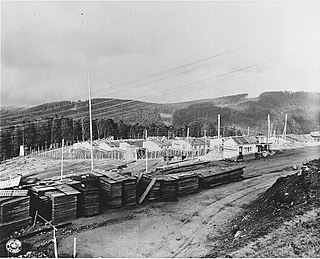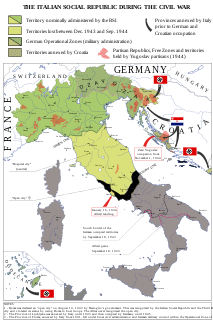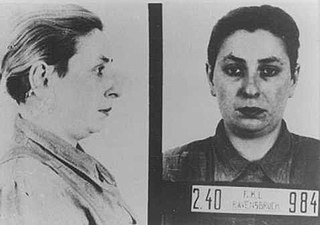
Camp Westerbork was a transit camp in Drenthe province, northeastern Netherlands, during World War II. Established by the Dutch government in the summer of 1939, Camp Westerbork was meant to serve as a refugee camp for Jews who had illegally entered the Netherlands.

Cottbus is a university city and the second-largest city in Brandenburg, Germany. Situated around 125 km (78 mi) southeast of Berlin, on the River Spree, Cottbus is also a major railway junction with extensive sidings/depots. Although only a small Sorbian minority lives in Cottbus itself, the city is considered as the political and cultural center of the Sorbs in Lower Lusatia.

Oranienburg is a town in Brandenburg, Germany. It is the capital of the district of Oberhavel.

Natzweiler-Struthof was a Nazi concentration camp located in the Vosges Mountains close to the villages of Natzweiler and Struthof in the Gau Baden-Alsace of Germany, on territory annexed from France on a de facto basis in 1940. It operated from 21 May 1941 to September 1944, and was the only concentration camp established by the Germans in the territory of pre-war France. The camp was located in a heavily-forested and isolated area at an elevation of 800 metres (2,600 ft).

Stargard(listen) is a city in northwestern Poland, with a population of 71,017 (2005). Situated on the Ina River it is the capital of Stargard County and since 1999 has been in the West Pomeranian Voivodeship; prior to that it was in the Szczecin Voivodeship (1975–1998).
Margot Elisabeth Dreschel, also spelled Drechsler, or Drexler, was a prison guard at Nazi concentration camps during World War II.

Gross-Rosen was a network of Nazi concentration camps built and operated by Nazi Germany during World War II. The main camp was located in the German village of Gross-Rosen, now the modern-day Rogoźnica in Lower Silesian Voivodeship, Poland; directly on the rail-line between the towns of Jawor (Jauer) and Strzegom (Striegau).

From 1933 to 1945, Nazi Germany operated more than a thousand concentration camps on its own territory and in parts of German-occupied Europe.

The Atlit detainee camp was a detention camp established by the authorities of the British Mandate for Palestine at the end of the 1930s on the Israeli coastal plain, 20 kilometers (12 mi) south of Haifa. The camp was established to prevent Jewish refugees from entering Mandatory Palestine. Tens of thousands of Jewish refugees were interned at the camp, which was surrounded by barbed wire and watchtowers.

Fuhlsbüttel (help·info) is an urban quarter in the north of Hamburg, Germany in the Hamburg-Nord district. It is known as the site of Hamburg's international airport, and as the location of a prison which served as a concentration camp in the Nazi system of repression. As a result of boundary changes, JVA Fuhlsbüttel prison is now in Ohlsdorf, Hamburg.

There were internment camps and concentration camps in France before, during and after World War II. Beside the camps created during World War I to intern German, Austrian and Ottoman civilian prisoners, the Third Republic (1871–1940) opened various internment camps for the Spanish refugees fleeing the Spanish Civil War (1936–1939). Following the prohibition of the French Communist Party (PCF) by the government of Édouard Daladier, they were used to detain communist political prisoners. The Third Republic also interned German anti-Nazis.

During the Holocaust, children were especially vulnerable to death under the Nazi regime. According to estimations, 1.5 million children, nearly all Jewish, were murdered during the Holocaust, either directly or as a direct consequence of Nazi actions.

After Adolf Hitler came into power in 1933 and enacted policies that would culminate in the Holocaust, Jews began to escape German-occupied Europe and the United Kingdom was one of the destinations. Some came on transit visas, which meant that they stayed in Britain temporarily, while waiting to be accepted by another country. Others entered the country by having obtained employment or a guarantor, or via Kindertransport. There were about 70,000 Jewish refugees who were accepted into Britain by the start of World War II on 1 September 1939, and an additional 10,000 people who made it to Britain during the war.

Janowska concentration camp was a Nazi concentration camp combining elements of labor, transit and extermination camps. It was established in September 1941 on the outskirts of Lwów in Eastern Poland / Western Ukraine. The camp was named after the nearby street Janowska in Lwów of the interwar Second Polish Republic.

The Holocaust in Belgium was the systematic dispossession, deportation, and murder of Jews and Roma in German-occupied Belgium during World War II. Out of about 75,000 Jews in the country in 1940, around 24,000 were murdered during the Holocaust.

The Holocaust in Italy was the persecution, deportation, and murder of Jews between 1943 and 1945 in the Italian Social Republic, the part of the Kingdom of Italy occupied by Nazi Germany after the Italian surrender on September 8, 1943, during World War II.

After Adolf Hitler came into power in 1933, Jews began to escape German-occupied Europe.

The phrase "Nazi concentration camp" is often used loosely to refer to various types of internment sites operated by Nazi Germany. However, Nazi concentration camps specifically refers to the camps run by the Concentration Camps Inspectorate and later the SS Main Economic and Administrative Office. Other types of detention and murder facilities employed by the Nazi regime included:

Henny Schermann was a Jewish lesbian from Germany, who was murdered in Bernburg Euthanasia Centre.

















